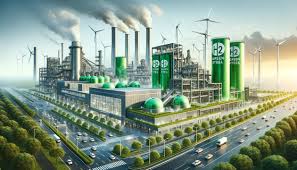Context:
Recently, the Minister of State for Steel and Heavy Industries informed the steps and policies adopted by the Government to encourage the steel industry to green transition.
- The government has introduced a roadmap and action plan to encourage the adoption of green steel manufacturing and support the steel sector’s green transition, aiming for net zero carbon emissions by 2070.
About Green Steel

- Green steel refers to the use of eco-friendly and sustainable methods in steel production.
- It usually involves using renewable energy sources, reducing carbon dioxide emissions, and minimizing and recycling waste during the production process.
- It can be achieved by using electric arc furnaces powered by renewable energy, fed with steel scrap and directly reduced iron, and transitioning from fossil fuels to hydrogen or electricity in downstream processing.
- Some steel companies in India that are working to produce green steel include JSW Steel, ArcelorMittal Nippon Steel India, and Tata Steel.
- Tata Steel is considering using nuclear power to produce green steel.
- The first delivery of ‘green steel‘ was done in Sweden by Hybrit to truck manufacturer Volvo AB.
- China is the largest producer of green steel in the world, accounting for almost half of the world’s total output.
- Other major green steel-producing countries include Japan, India, South Korea, and the United States.
Key initiatives to decarbonize India’s steel sector include:
- National Mission for Enhanced Energy Efficiency (NMEEE): Part of the National Action Plan for Climate Change (NAPCC).
- Perform Achieve & Trade (PAT) Scheme: A market-based mechanism to improve energy efficiency through Energy Saving Certificates (ESCerts).
- Green Steel Taxonomy: India became the world’s first country to define a carbon footprint standard for steel production.
- Other Initiatives: Green Hydrogen Energy Mission, National Solar Mission, and Steel Scrap Recycling Policy (2019).
Significance:
- Sustainability: Green steel production reduces the environmental impact of steel production and helps to make it more sustainable.
- Climate change mitigation: Steel production is a main contributor to greenhouse gas emissions. Green steel production helps to moderate the effects of climate change by reducing emissions and increasing energy efficiency.
- Economic benefits: Green steel production can create new jobs and stimulate economic growth, as well as improve the competitiveness of the steel industry.
- Legal requirements: Many countries have set targets and standards for reducing greenhouse gas emissions, and green steel production helps to meet these requirements.
Steel Manufacturing in India
Steel is an alloy of iron and carbon containing less than 2% carbon and 1% manganese and small amounts of silicon, phosphorus, sulphur and oxygen.
- India is currently the world’s 2nd largest producer of crude steel after China.
- It was also the largest producer of Direct Reduced Iron (DRI) or Sponge Iron and ranked as the 2nd largest consumer of finished steel.
- Odisha is the leading state in India for the production of iron followed by Chhattisgarh, Karnataka, Jharkhand, and Madhya Pradesh
- Important steel plants under public sector:
- Durgapur: West Bengal
- Salem: Tamil Nadu
- Bhilai: Chhattisgarh
- Rourkela: Orissa
- Bokaro: Jharkhand
- Visakhapatnam: Andhra Pradesh
- Visvesvaraya Iron and Steel Plant (Bhadravati): Karnataka

